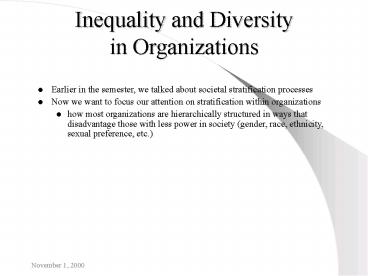Inequality and Diversity - PowerPoint PPT Presentation
1 / 11
Title:
Inequality and Diversity
Description:
Earlier in the semester, we talked about societal stratification processes ... power are often labeled 'iron maiden', 'controlling' or 'bossy', Kanter argues ... – PowerPoint PPT presentation
Number of Views:133
Avg rating:3.0/5.0
Title: Inequality and Diversity
1
Inequality and Diversity in Organizations
- Earlier in the semester, we talked about societal
stratification processes - Now we want to focus our attention on
stratification within organizations - how most organizations are hierarchically
structured in ways that disadvantage those with
less power in society (gender, race, ethnicity,
sexual preference, etc.)
2
Historical Background
- Up until the late 1960s, most large organizations
were run by white men and had a very high
concentration of white men in managerial
positions (women were secretaries, racial and
ethnic minorities did dirty work--custodial,
manufacturing etc.) - Civil Rights and Feminist movements in the late
1950s and through the 1960s began to challenge
broader societal stratification structures,
including those in organizations
3
Tapping the Power of Diversity
- Equal Employment Opportunity Act (part of 1964
Civil Right Act) - No discrimination
- Affirmative Action policies and departments in
organizations - Rise of Tokenism--very slow progress
- Slow to no progress led to the emergence of new
kinds of social movements inside and outside of
organizations to challenge organizational
stratification systems - This has given rise to the notion of Diversity
Management
4
Diversity Management Rational Natural Systems
Interpretations
- From a managerialist (rational systems)
perspective, it is argued that diversity can
improve organizational performance - by bringing fresh viewpoints, different
experiences, and new knowledge, diversity has the
potential to enliven, invigorate, and recreate - From a conflict (natural systems) perspective,
diversity training programs and policies offer a
mechanism for those in power to appease different
status groups (race, class, gender etc.) while
retaining control over workers
5
What is Being Challenged?
- Social Similarity (Homophily)--people like those
who are similar to them and will tend to hire,
promote and reward those who are socially similar - Even if minorities can break into the upper
management ranks (formal position), it is often
difficult to become a part of the informal social
networks based on homophily - As Bakers XYZ race relations example shows,
status groups may also have divergent perceptual
differences about organizational processes (e.g.
hiring of black managers based on
competence-white males 64, black males 90)
6
Comparable Worth
- Womens earnings are systematically lower than
Mens (between 60-70 since the 1950s - It turns out that there are many jobs that are
predominantly female and are, therefore,
considered female jobs (referred to as the
gendering of work) - E.g. Typists, Nurses, Community service workers,
Accounting clerks etc. - In jobs that are predominantly female, women make
systematically less than comparable jobs that are
done by mostly men
7
How to Challenge Extant Power Structures?
- Creation of informal networks and social
movements within and across organizations - e.g. black caucus at Xerox
- While it is key to form a coherent identity and
strong network, it is equally important to
establish ties to those in power (Kanter) - need to balance the strength of the movement with
more pragmatic aspects of social change - Underrepresented minorities need to gain
positions of higher status within the
organization (Baker)
8
Power in Organizations
- Kanter makes a distinction between Authority and
Power - Authority has to do with formal positions in a
hierarchy that gives people the right to command - Power has to do with influence (processes and
people beyond immediate work area), access to
resources etc. - E.g. first-line supervisors in highly routinized
functions or staff positions (equal employment
opportunity officers) often have little power
9
Gender, Power and Organizations
- Kanter argues that women in organizations have
made some gains in obtaining positions that have
formal authority, but they remain powerless - While women in power are often labeled iron
maiden, controlling or bossy, Kanter argues
that these kinds of behaviors are influenced by
positions of powerlessness, not because of
gender! - Hence, officers of lower status and advancement
potential favor more directive, rigid and
authoritarian techniques of leadership - When people have more power and expect to be
successful, milder forms of influence are used
10
Gender, Power and Organizations
- Vicious cycle--powerful authority figures who use
coercive tactics provoke resistance and
aggression, which prompts them to become even
more coercive, controlling, and behaviorally
restrictive - The general argument is that there are gender
stereotypes about leadership that turn out to be
wrong when you analyze the role of power in
organizations - To kill this myth, however, women need to gain
more positions of power (not just authority) - To do this, they need to form alliances with each
other and help each other to the top
11
Diversity Limits
- Organizations are comprised a various status
groups (managers/workers men/women black,
white, hispanic) who have an unequal degree of
power - Those that have power will often resist
organizational changes that threaten to diminish
their power (Acker) - To the extent that hierarchy is correlated with
salient status group distinctions, organizational
hierarchy will tend to be reproduced (Acker) - Organizations, in turn, can become battlegrounds
for broader societal conflictsnot just rational
tools to maximize profits











![Download Book [PDF] The Journey of Humanity: A New History of Wealth and Inequality with PDF PowerPoint PPT Presentation](https://s3.amazonaws.com/images.powershow.com/10107187.th0.jpg?_=20240824039)




![[PDF] Fast Facts about Diversity, Equity, and Inclusion in Nursing: Building Competencies for an Antiracism Practice Free PowerPoint PPT Presentation](https://s3.amazonaws.com/images.powershow.com/10076343.th0.jpg?_=20240710089)














